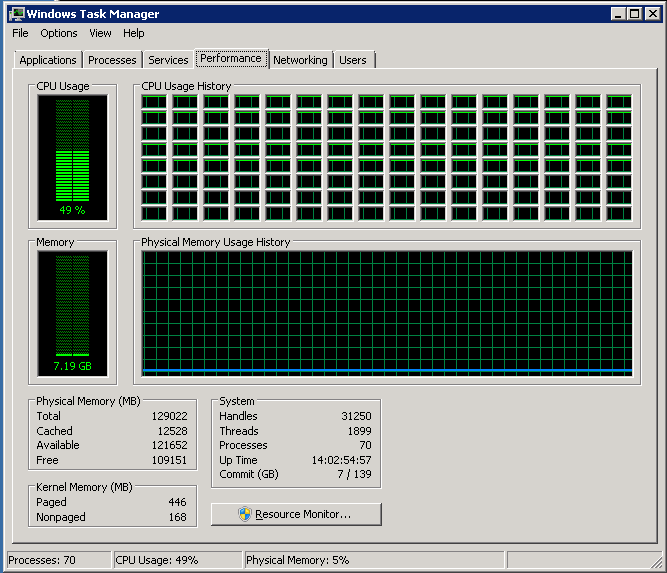CRAY CX1-iWS
Dunno if you've seen this yet, but I want one! Cray CX1-iWS. Not sure I can afford the $38k price tag though.
It got me thinking, I wonder if commodity hardware will start moving that way in 5 years - at the moment Dual/Quad core is becoming normal and we're unlikely to see any huge speed up in CPUs, so do we think that we'll reach 24 cores at home any time soon?
Interesting about the Cray is the fact that they're also pushing the use of CUDA for parallelism on the GPU. I'm still thinking that we'll see more of this stuff happening, including Larrabee - but I'm not sure when they'll get that into the home.
Actually, they are already selling 24 core capable motherboards like the EVGA Classified SR-2 Motherboard. So you can have a 24 core gaming rig if you are willing to shell out $600 just for the motherboard. Way cheaper than the Cray system still though.
"Two 6-cores CPU mean 12 real cores. Now if you enable Intel HyperThreading technology, the number of cores jumps to 24. Wow… 24 cores, 24 real hardware threads"
Still until more software takes advantage of all the threads it's all mostly just for bragging rights.
"Two 6-cores CPU mean 12 real cores. Now if you enable Intel HyperThreading technology, the number of cores jumps to 24. Wow… 24 cores, 24 real hardware threads"
Still until more software takes advantage of all the threads it's all mostly just for bragging rights.
[size="2"]Don't talk about writing games, don't write design docs, don't spend your time on web boards. Sit in your house write 20 games when you complete them you will either want to do it the rest of your life or not * Andre Lamothe
Quote: Original post by evolutional
Interesting about the Cray is the fact that they're also pushing the use of CUDA for parallelism on the GPU. I'm still thinking that we'll see more of this stuff happening, including Larrabee - but I'm not sure when they'll get that into the home.
To be honest, I wouldn't have said we are that far off.
Right now I'm sitting on a machine which has;
- 4 cores, 8 hardware threads (and if I had the cash I could bump that to 6/12)
- AMD HD5870 which gives me 1600 'cores' via D3DCompute/OpenCL
- NV GT240 which has 96 CUDA cores via CUDA/D3DCompute/OpenCL
That's a fair wack of computing power right there.
Quote: Original post by phantomQuote: Original post by evolutional
Interesting about the Cray is the fact that they're also pushing the use of CUDA for parallelism on the GPU. I'm still thinking that we'll see more of this stuff happening, including Larrabee - but I'm not sure when they'll get that into the home.
To be honest, I wouldn't have said we are that far off.
Right now I'm sitting on a machine which has;
- 4 cores, 8 hardware threads (and if I had the cash I could bump that to 6/12)
- AMD HD5870 which gives me 1600 'cores' via D3DCompute/OpenCL
- NV GT240 which has 96 CUDA cores via CUDA/D3DCompute/OpenCL
That's a fair wack of computing power right there.
Yeah the coolest thing I"ve seen in a while was actually this:
University of Antwerp stuffs 13 GPUs into FASTRA II supercomputer
They crammed so many videocards in that they needed a custom case not to mention a custom bios to boot!
"loading up a custom BIOS courtesy of ASUS, they were apparently able to get six dual-GPU NVIDIA GTX295 cards and one single-GPU GTX275 card up and running"
[size="2"]Don't talk about writing games, don't write design docs, don't spend your time on web boards. Sit in your house write 20 games when you complete them you will either want to do it the rest of your life or not * Andre Lamothe
Personally, CPU's are already so fast there's little point to faster in the mainstream consumer market. That's because it isn't the bottleneck, the HDD is. SSD's are going to change that. I believe that will allow applications that would be nothing but a pipe dream today no matter the speed of the CPU or how many streaming processors you have.
Keys to success: Ability, ambition and opportunity.
If things keep going this way, the task manager is going to need a redesign ;)

As for everyday consumer market, I'd say CPUs are still bottlenecked thanks to the amount of crap loaded into the system tray and the endless browser toolbars and plugins ;)

Quote: Original post by daviangelThat is pretty cool, but it's really 12 cores, 24 hardware threads... HT isn't the same as doubling the amount of cores.
"Two 6-cores CPU mean 12 real cores. Now if you enable Intel HyperThreading technology, the number of cores jumps to 24. Wow… 24 cores, 24 real hardware threads"
Quote: Original post by LilBudyWizerFor a lot of games though, the CPU is a bottleneck - there's always more "stuff" you can be calculating...
Personally, CPU's are already so fast there's little point to faster in the mainstream consumer market. That's because it isn't the bottleneck, the HDD is. SSD's are going to change that.
As for everyday consumer market, I'd say CPUs are still bottlenecked thanks to the amount of crap loaded into the system tray and the endless browser toolbars and plugins ;)
. 22 Racing Series .
Quote: Original post by LilBudyWizer
Personally, CPU's are already so fast there's little point to faster in the mainstream consumer market. That's because it isn't the bottleneck, the HDD is. SSD's are going to change that. I believe that will allow applications that would be nothing but a pipe dream today no matter the speed of the CPU or how many streaming processors you have.
Actually, there are still some games that are still cpu bound, i.e. Flight Simulator X, but it is one of those rare games that sees little improvement even if run on a 6Ghz cpu LOL!
[size="2"]Don't talk about writing games, don't write design docs, don't spend your time on web boards. Sit in your house write 20 games when you complete them you will either want to do it the rest of your life or not * Andre Lamothe
With many games the CPU is only a bottleneck if you view 300 fps as a necessity. SSD's are 10 times or more faster at random IO and 2-3 times faster at sequential reads. That is just a start. Data is the fuel that powers the engine. There is always more to be computed, but there are only a few esoteric applications making those computations of any practical value without data. You have to feed the beast. That, to me, is the problem causing software to stall. You can't use 24 threads because you can't feed 24 threads. They end up just setting there doing nothing waiting for a signal that some data is finally available.
Keys to success: Ability, ambition and opportunity.
But most games do all their disk IO on the loading screen, and then don't touch the disk at all during gameplay. The problem when trying to feed 24 threads is that the RAM/cache becomes the bottleneck ;)
. 22 Racing Series .
This topic is closed to new replies.
Advertisement
Popular Topics
Advertisement
Recommended Tutorials
Advertisement









